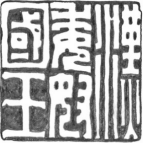4.11: The Yayoi Period on the Archipelago
- Page ID
- 135176
Before you continue: can you read one or more of the characters on this seal?

The Lelang commandery also managed Han imperial relations with the archipelago. The History of Latter Han records an embassy from Wa on the archipelago, that arrived in Lelang in 77 Chapter 4, p.21 AD 57. (A second Wa embassy came in AD 107.) In 1784, a Korean farmer discovered on his land a gold seal with a knob on top in the form of a snake. Scholars mainly agree that it was the very seal that the Han court sent in AD 57 to the head of a small state in the archipelago. The seal says: “漢倭奴國王 Han-designated King of the Na Country of Wa.” Historians do not know exactly where Na was in the archipelago, – and neither did the Han government.
It is no surprise that Wa chiefs in the archipelago knew about the new wealthy elite power on the peninsula, because they were closely connected with tribes at its southern tip, who had already been part of the trading circuit for a century or more. From the northern coast of Kyushu in Japan to Pusan in Korea is about 150 miles, and from Pusan one can see Tsushima Island, halfway between the two. Since at least 10,000 BC, a few people had been making the trip by boat, carrying jewelry and useful things in distinctive styles, like shell fishing hooks and shell beads with faces carved into them.22
In about 600 BC (according to archaeologists) or 300 BC (according to historians), a regular stream of peninsular people, mainly from the far south, made the journey to Tsushima Island, and then to Kyushu. They may have been escaping climate changes that had made it harder to grow rice in the peninsula. Over several hundred years they kept coming, settling in with the Jōmon people of Kyushu, intermarrying and thus sharing customs like the style of graves, grave goods, enclosure of settlements by a moat, the shape of houses. They brought the knowledge of how to grow rice (riziculture), and they brought domesticated pigs.

Once the Han commanderies had initiated an iron industry in the southern peninsula, immigrants and trade brought iron from Chinhan and Pyŏnhan to Kyushu, for useful things like large, flat, iron axeheads. They brought the technology of enclosed cookstoves of clay and stone that not only used less fuel to cook than an open hearth, but also heated a house with clay pipes that carried the smoke and heat around the inside walls of a house. Even a house that was just a pit in the ground with some kind of roof could be warmer and more comfortable with such a 78 Chapter 4, p.22 hypocaust. The enclosed cookstoves made it from Kaya to northern Kyushu in the late AD 200s.23 Some coastal communities grew enough surplus rice that their members could spare the time to make extra agricultural tools – first stone, then iron – to trade further south in Kyushu.
By the second century AD, some Wa chiefs had formed statelets 10 to 12 miles apart from one another along the Kyushu coast. The chiefs claimed predominance over their neighbors with elegant, imported bronze daggers and mirrors; when imports slowed, they made them in their own styles. As happened in the New Stone Age on the mainland, what had been egalitarian communities (shown by shared ritual bronze caches) were now dominated by local chiefs (buried with their own bronzes). Fighting began in Kyushu, perhaps when the various clans faced climate changes.24 And trade routes to Shikoku and Honshu linked chiefs there to the goods and techniques of the mainland. By AD 200, competition within communities and between statelets was becoming violent.
Immigrants from the peninsula, bearing knowledge from the mainland funneled through the commanderies, made a lasting impact on the archipelago: the outermost wave of the impact of Wudi’s war against the Xiongnu confederation.


